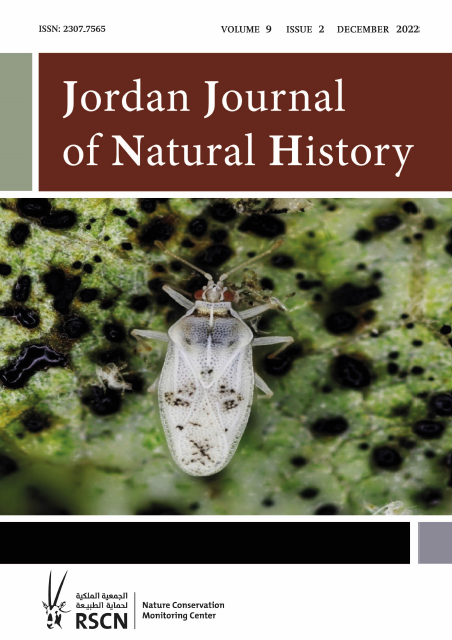Articles
Further Collection of Scorpions from Saudi Arabia
Author Name
Abdulhadi Aloufi, Bassam Abu Afifeh, Zuhair S. Amr
Additional distributional data on the scorpions of Saudi Arabia are presented for eight species, covering 31 localities in Al Madinah Al Monawwarah, Jazan, Riyadh, and Tabuk provinces. In addition, high resolution images are provided for each species. Such data are useful for mapping the scorpions of Saudi Arabia
Snakes from Jazan Province, Saudi Arabia
Author Name
Abdulhadi Aloufi, Zuhair S. Amr, and Mohammad A. Abu Baker
Eleven species of snakes belonging to six families (Colubridae, Psammophiidae, Lamprophiidae, Viperidae, Elapidae and Atractaspididae) are reported herein from Jazan Province. Data on their ecology are presented along with a zoogeographical analysis of species of African affinities.
Different Evolutionary Causes of Clutch Size in the Asaccus/Haemodracon Cluster (Squamata: Gekkota: Phyllodactylidae)
Author Name
Herbert Rösler and Wolfgang Wranik
Gekkota differ in their clutch sizes. This phenomenon is particularly evident in the variable double-egg clutches and practically invariant single-egg clutches. The clutch size developed from a selection of different life history characteristics. The reduction to a single egg is the most recent evolutionary adaptation of gecko’s clutch size. In the Asaccus/Haemodracon cluster, both clutch sizes are known for geckos. The singleegg clutches developed convergently in the lineage and are (1) a generic feature (Asaccus) and (2) an intraspecific feature (Haemodracon). As biotic selection factors, possibly (1) predator-prey relationships and (2) food net patterns have contributed to the miniaturization of the invariant clutch size in the selected species. The regulated reproductive efforts have led to a reduction in adult mortality and an increase in the survival rate of offspring
First Record of the Poplar Lace Bug, Monosteira unicostata (Mulsant & Rey, 1852) (Hemiptera: Tingidae), from Jordan
Author Name
Ahmad Katbeh Bader and Ibrahim Al-Jboory
The poplar lace bug, Monosteira unicostata (Mulsant & Rey, 1852) (Hemiptera: Tingidae) is recorded for the first time from Jordan. It was found in many localities in Amman associated with the predator Oenopia conglobata (Linnaeus, 1758) (Coleoptera: Coccineliidae) which is also recorded for the first time in Jordan. In addition, a predatory bug, Anthocoris sp. (Hemiptera: Anthocoridae) was observed consuming the immatures of the lace bug
The Geranium Bronze Butterfly, Cacyreus marshalli (Butler, 1898) (Lycaenidae: Lepidoptera), A New Invasive Species and Additional Records to the Butterfly Fauna of the Palestinian Territories
Author Name
Elias Nabil Handal
This is the first report on the Geranium Bronze Butterfly, Cacyreus marshalli from the Palestinian Territories. This invasive species was collected from Bethlehem city from two locations in house gardens feeding on Pelargonium sp. and Geranium sp.
First Record of Milnesium Doyère, 1840 (Tardigrada: Apochela) from the Western Ghats, India
Author Name
Elssa Ann Koshy and Raveendranathanpillai Sanil
Tardigrades are the strongest micro invertebrates on the planet, and their ability to thrive in climatic and pressure extremes is currently gaining attention. The researchers report for the first time the presence of Milnesium (Order: Apochela, Class: Eutardigrada) from mosses in the high-altitude of the Nilgiris (2500 msl) in the Western Ghats, as well as observations on its clutch size and egg-laying behaviour. Milnesium is a highly tolerant species that has been offered as a candidate for space travel. Until now, just one Milnesium species has been documented in India, making the present observation extremely significant. The genus is distinguished by its cuticle sculpture, cuticular characteristics, six peribuccal papillae and two lateral ones, six peribuccal lamellae, and a bucco-pharyngeal bulb devoid of placoids or septum, in addition to its distinctive claws. By providing rotifers and ciliates to the species, the researchers were able to cultivate them successfully in the hay infusion medium. Milnesium was observed moulting and laying between one to seven eggs per clutch, which were always found adhered to the exuvia. In this instance, a high-altitude sighting of this species during extreme weather is crucial because the genus is able to withstand harsh conditions such as low temperatures and ionising radiation.
Parental Care in the Early Days of a Fledgling of the Clay-colored Thrush (Turdus grayi)
Author Name
Lucía I. Lopez and José Manuel Mora
The clay-colored thrush (Turdus grayi) is common in altered habitats (e.g., thickets), artificial (e.g., crop fields), and forest edges. The species nests from March to June in a cup-shaped nest typical of passerines where the female lays two to three eggs. Parents incubate the eggs for twelve to thirteen days and care for the nestlings for twelve to eighteen days. There is no information about what happens to the fledglings just after departure from the nest. On 1 May 2022, the researchers found a fledgling clay-colored thrush on the ground of a garden in a rural area in Carrizal de Alajuela, Costa Rica at 1700 m asl. The fledgling was followed for a week, during which time it was cared for and fed by the parents. This note provides information on the relationship between the fledgling and its parents.
A Defensive Attack by a Social Carnivore (White-nosed coati) against a Constrictor Predator (Mesoamerican boa constrictor)
Author Name
Juan de Dios Astorga and José Manuel Mora
Ecological interactions are one of the most complex aspects of tropical biodiversity; among these, predation stands out due to the impact it has both on prey and predators. Two of the most prominent groups of predators in the tropics are snakes (Reptilia) and mammalian carnivores. White-nosed coati Nasua narica (Mammalia: Carnivora: Procyonidae) and the Mesoamerican boa Boa imperator (Reptilia: Squamata: Serpentes: Boidae) interact in cross-predatory events that depend on the size of the individuals involved. On 21 November 2019, at 1637h, the researchers observed a herd of thirty seven coatis, where a subgroup of twenty three individuals, made up of mostly adult females and some young males, were aggressively attacking a large boa. The attack could have been a defensive reaction of the females of the herd who, perceiving a potential threat to their young, reacted aggressively to drive away the predator. This work reviews and places this observation in the context of previous records of interactions between these two species.




